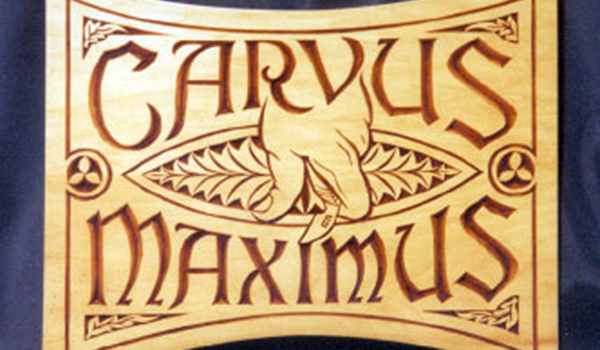
Wayne Barton must be the youngest 67-year-old woodworker on the face of the earth. Fit, diminutive, and lithe, this former circus performer and treasure hunter bristles with energy and a joi de vivre that infects both his teaching and his work. That work, and the passion he brings to it, has brought him recognition as the finest chip carver in America, and perhaps well beyond.
Though he is well versed in all carving disciplines, he specializes in chip carving, and has devoted himself to its advancement. Single handedly, he has been the driving force behind the recognition and renaissance chip carving has enjoyed in North America this past quarter century.
“Chip carving was not very well known at the time in this country. In fact, it was not even a category in most carving competitions. It occurred to me that it was something anyone could learn easily, and you didn’t need to be an artist to do it. The tools were simple, and those who saw me carve were fascinated. It was a niche that needed filling.”
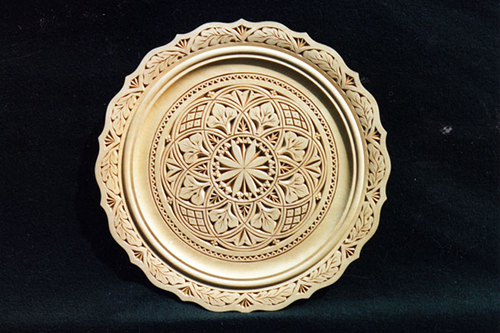
Barton calls chip carving the fastest, easiest and simplest way there is to carve. “The tools are few, and the technique is quite basic. Being a decorative form of carving, it has a wide application. Most importantly, it is a type of carving that most anyone can do with pleasing results.”
“It is different from all other forms of carving in several ways. Instead of forming an object, it creates surface decoration on the object, whether it is a box, a fireplace mantle or bed. All other forms of carving involve a shaving process – you shave away what you don’t want in order to form an object. Chip carving makes precise cuts that remove a chip of a specific shape, as opposed to a shaving. Hence, the name ‘chip carving’ does not refer to the design, but rather to the debris on the floor.”
The best woods to carve, and the ones most commonly used, are basswood, butternut and white pine. These woods are tight, even, straight-grained woods that allow you to cross the grain with ease. As you can see, chip carving works on both hardwoods and softwoods.
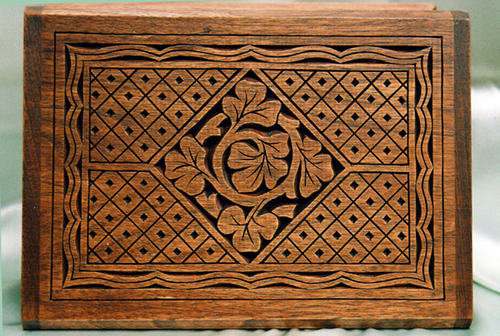
“All my carving is done with just two knives: a cutting knife, which removes all wood, and a stab knife, which cuts and spreads wood into small wedge-shaped embellishments used to ornament the basic pattern. In fact, you could do an entire design with just a cutting knife, or just a stab knife, but I typically use both, spending more time with the cutting knife.”
His Norwegian grandfather started teaching him woodcarving when Wayne was just five years old, and he’s been doing it ever since. “When I finally determined that carving was my life’s passion, I went to study with some of the Swiss masters in Brienz, the woodcarving center of Switzerland.” While there, he studied bas relief, deep relief, and three-dimensional carving in addition to chip carving.
A frustration over the lack of the right tools induced him to develop his own line of American-made chip carving knives. They incorporate his improvements on the Swiss knives he learned with. Today, they are carried by most woodworking specialty stores and, of course, are available from his web site.
The same frustration led to his developing a line of ceramic sharpening stones. “When I started teaching about three decades ago, students would show up with all manner of sharpening stones, most of which were inadequate. What is good for putting an edge on a field axe is not necessarily appropriate for chip carving knives.” After looking at the alternatives, he concluded that ceramic stones were best for his craft. Ceramic stones do not need water or oil, are readily available, and are fine enough to put a mirror finish on carving knives. They are so hard that they will not dish, will never wear out, and don’t ever need to be dressed. Failing to find the right stones for his market, he designed and purchased his own molds to make appropriately sized ceramic stones available to his students.
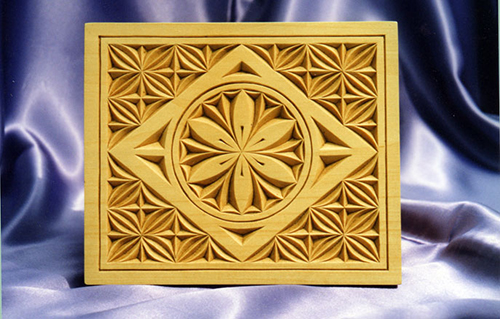
Beyond carving, Barton’s life is peppered with fascinating career highlights. A star athlete throughout school, he once worked in the high altitude job of tree topper, something only for those both fit and fearless. Thanks to an uncle on the flying trapeze, he went on to join the Clyde Beaty – Cole Brothers Circus. At the time, it was the largest tent circus in the world. “In the world of trapeze, there are catchers and fliers. I was a flier. It didn’t last long, but it was loads of fun, and I got to work with many of the famous names in circus.”
Prior to college, where he studied psychology, he served a stint with the Coast Guard. Stationed at a lighthouse, he had lots of time for carving. This maritime influence led him to become a deep-sea treasure hunter when he was offered the opportunity to do some salvage diving in South America. He was a diver and deck master on an expedition to find 30 tons of silver bars that Sir Francis Drake had dumped over the side of his famous ship, The Golden Hind. The silver had been taken, along with gold, in a raid on a Spanish treasure barge. Drake used the precious cargo as ballast. When he needed to dump ballast, he dumped the silver, which was less valuable than the gold.
Wayne is the founder of The Alpine School of Woodcarving, Ltd., the oldest establishment in North America specializing in, and dedicated to, the teaching and encouragement of chip carving. In addition, he teaches at a variety of other venues including colleges, clubs, institutions and organizations across the United States, Canada and Switzerland. He is also a visiting artist/lecturer at the esteemed Art institute of Chicago in that city. His carvings are sought after by collectors around the world, and he is the only American chip carver whose work has been recognized and honored in special exhibitions at the Swiss National Museum in Zurich, Switzerland.
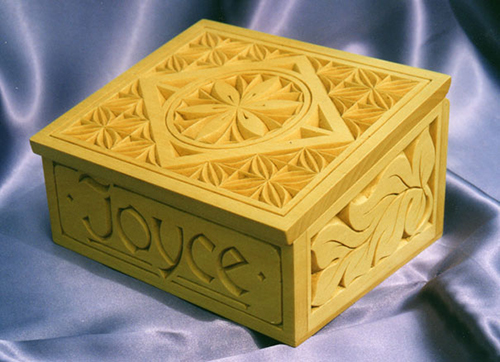
Like many of our best teachers, Barton also writes. Noticing that there was no good literature available in English, he wrote his first book on the subject in 1983. That book, which became the seminal text in the field in this country, is still available, and currently in its 12th printing. Since then, he has written four other books and produced one video on the subject.
Today, he continues carving, teaching and introducing others to this most enjoyable, decorative and easy-to-learn style of carving. For him, it is a labor of love.
“You must follow your passion,” he advises. “You must wake up every day looking forward to what you do.”





